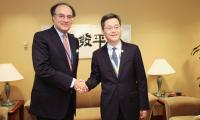Islamabad
To help in generating reliable data on violence against women (VAW) in Pakistan, the National Commission on the Status of Women (NCSW) on Friday launched the standardised Pakistan specific indicators on VAW.
The Pakistan specific indicators have been finalised by NCSW after an extensive review of the existing UN indicators as well as indicators under use from different countries by an 18-member Technical Working Group. The indicators were developed by NCSW under a project ‘Countering GBV through Research, Data Strengthening and Standardisation’ which is supported by the Gender Equity Programme of Aurat Foundation and funded by the USAID.
The NCSW also announced its plans to conduct a survey on VAW in collaboration with National Institute of population studies in near future.
The event started with a detailed briefing by Consultant for developing VAW indicators for NCSW Yasmeen Zaidi on the key categories of indicators on VAW which include physical, sexual, economic, psychological violence, violence in the political arena and culturally harmful practices. Most indicators are same as has been standardised in UN statistical division with an addition of violence against women in politics.
She shared that recent data from the Pakistan Demographic and Health Survey (PDHS) 2012 to 2013 on the prevalence of physical and emotional violence experienced by ever married women ages 15-49 indicates that spousal violence is high in Pakistan. Almost 40 per cent of married women had experienced spousal abuse at some point in their life, whether physical or emotional, and one-third reported having experienced some form of physical or emotional violence by their husbands over the previous 12 months.
“Emotional violence is the most commonly reported form of spousal violence (32%). Spousal violence is most common among those with no education and women employed for cash (both 44 per cent). And least common among women with higher education (20 per cent) and from the wealthiest households (24 per cent),” said Yasmeen.
The event was attended by women’s rights activists, academics and researchers, legal and technical experts, government officials from key ministries and representatives from Pakistan Bureau of Statistics and National Institute of Population Studies (NIPS).
NCSW Chairperson Khawar Mumtaz briefed the delegates about the key priority areas for the Commission. She thanked the members of the Technical Working Group for their input in finalising the Pakistan Specific indicators.
“Essentially meant to be used by government statistical agencies as well as research related organisations, these indicators are crucial in the long run as they will aid in generating reliable data on VAW in Pakistan. This data can be compared across time and regions, within and outside Pakistan”.
Chief of Party-Gender Equity Programme Simi Kamal also spoke at the event. She said that in past, data on VAW was generalised and was available in pockets. “We are glad to support the standardisation of VAW data which will make it concrete and globally comparable,” she said.
Deputy Director Stabilization and Governance programme of the USAID Edward Gonzales said that the Gender Equality Programme works for both the government and the civil society in Pakistan.
Chief Operating Officer of the Aurat Foundation Naeem Mirza talked about violence in media and language. He appreciated that there has been some policy change as well especially the law on ‘nikah nama’ in Punjab which now makes it mandatory for ‘nikah’ registrar to fill clause 18 or otherwise face fine and imprisonment.
Commuters make their way along a motorway as they enter the capital city Islamabad. — AFP/ FileIslamabad: National...
This image shows the National University of Technology building in Islamabad. — National University of Technology...
The image shows a tobacco company worker busy with cigarettes. — AFP FileIslamabad:The business community has raised...
Rescue workers help to evacuate flood-affected people in Punjab. — AFP/FileRawalpindi: The Water and Sanitation...
Allama Iqbal Open University building can be seen in this picture. — Allama Iqbal Open University...
This representational image shows the hands of a detained person. — AFP/FileRAWALPINDI: A District and Sessions...







